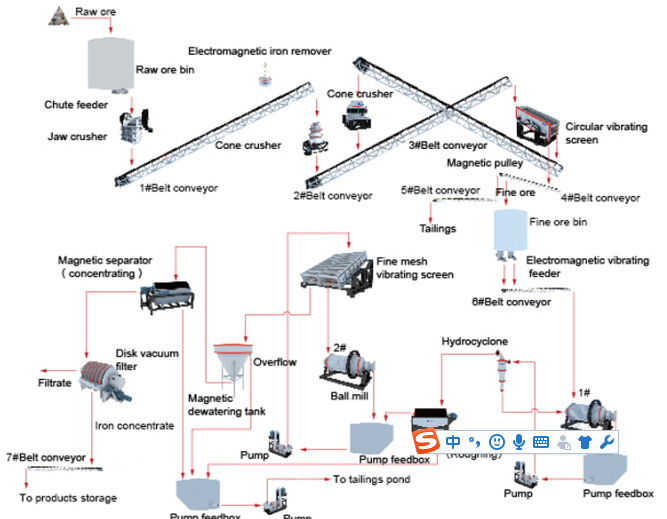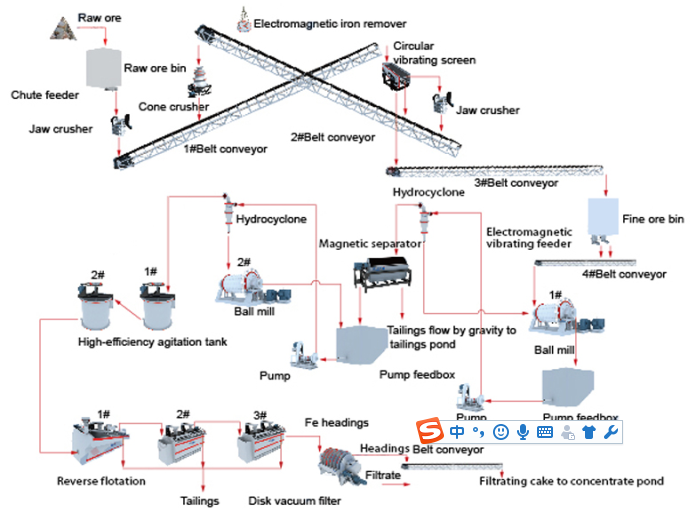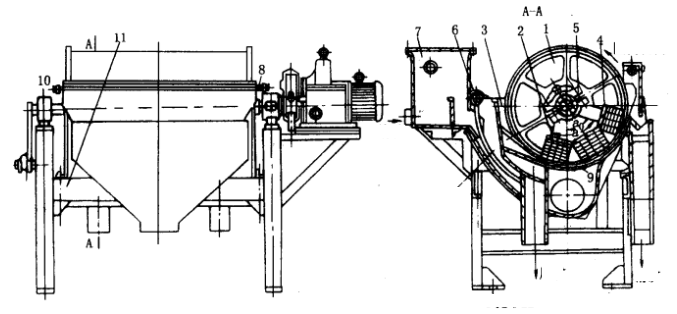There are many kinds of iron ores. According to the properties of different ores, it is necessary to adopt reasonable mineral processing methods to achieve the final beneficiation effect. The following are the ore dressing methods of various kinds of iron ores, respectively.
1. Magnetite
1.1. Single magnetite
This kind of ore is mainly sedimentary metamorphic magnet ore. Most of the iron minerals in ores are magnetite, mainly disseminated in fine grains, and gangue minerals are mainly silicate minerals such as quartz or hornblende, and some of them contain more iron silicate. This kind of ore has the longest history of ore dressing production. Because of the simple composition of the ore, the weak magnetic separation method is often used.
For large and medium sized magnetic plant, when the grinding particle size greater than 0.2 mm, often using a grinding magnetic separation; there is less than 0.2 meters, with two stage grinding magnetic separation. If the qualified tailings are separated from the coarse grinding energy, the stage grinding magnetic separation is adopted. Dry type magnetic separation of dry grinding ore is used in water shortage area. The rich magnetite ore or poor magnet ore, which is depleted, usually uses dry magnetic separation to remove the gangue, the former gets the massive ore, and the latter gets the concentrate through the grinding magnetic separation.
In order to obtain high grade concentrate, can be used in reverse flotation of magnetite concentrate or fine vibroscreen treatment. In order to improve the recovery rate, further recovery of tailings process.
At present, there is no reasonable way to use ferric silicate. Therefore, iron silicate in ore does not emphasize recovery. Although iron silicate can be recovered by mineral processing method, because iron grade in iron bearing silicate minerals is low, it will reduce the total concentrate grade greatly, which is unreasonable in economy. Generally speaking, the charge contains a certain amount of iron silicate, does not affect the large and medium-sized blast furnace, iron and silicate of iron from slag will not loss type; but in a small blast furnace, the iron silicate is an endothermic reaction in the smelting process, and low melting point, because of the burden iron silicate if a certain amount of time, it will reduce the temperature of the furnace is not smooth, and run the slag.

Figure1. Flowchart of magnetite beneficiation plant
1.2.Multi metal magnetite
The ore containing polymetallic magnets is mainly skarn type sulfide magnet ore and a few magmatic limestone containing apatite magnetite. Magnetite in ore is medium grain (2-0.2mm) to fine grain disseminated. Gangue has silicate or carbonate minerals, often associated with pyrite, cobalt pyrite or chalcopyrite and apatite. This kind of ore also has more ore dressing production practice. In general, the combined process of weak magnetic separation and flotation is used, that is, to recycle iron by weak magnetic separation and to recover sulfide or apatite by flotation. The principle of the process can be divided into weak magnetic separation flotation and flotation magnetic separation of two kinds of intergrowth to these two kinds of process with different magnetite sulfide. The previous process, intergrowth mainly into the iron concentrate after a process, mainly into sulphide concentrate. Therefore, under the same grinding granularity, the iron concentrate with low sulphide and high recovery rate of sulfide concentrate can be obtained by flotation after flotation. The depleted ore can also be removed by dry magnetic separation and fine grinding. Such minerals are often self fluxing, should pay attention to self fluxing keep concentrate. It is also difficult to separate ore from iron by mechanical mineral processing.
2. Weakly magnetic iron ore
2.1. Single Weakly magnetic iron ore
Such ores include hematite, siderite, limonite, hematite and siderite, including sedimentary metamorphic, sedimentary, hydrothermal and weathering deposits. This kind of ore selection and open production practice is less. Because of many kinds of minerals and wide range of granularity, there are more ore dressing methods. The common methods can be divided into two kinds.

Figure2. Flowchart of Hematite ore beneficiation plant
2.1.1. Magnetization roasting magnetic separation or parallel process with gravity separation, flotation and strong magnetic separation
Roasting magnetic separation is one of the effective methods to select fine particles (<0.02 millimeter) for weak magnetic iron ore. The magnetization roasting magnetic separation method should be used when the mineral composition of the ore is complex and it is difficult to get good index by other methods. The 75-20 mm block mine shaft furnace has been reduced and roasted for a long time, and the production practice of magnetized roaster in powder ore below 20 mm is less. At present, the powder ore is usually selected by the methods of strong magnetic separation, gravity separation, flotation and so on.
2.1.2. gravity, flotation, strong magnetic separation, or its joint process
Flotation is also one of the common methods to select fine particles for weak magnetic iron ore. There are two principles of positive flotation and reverse flotation. The former is suitable for quartz hematite without floating gangue, and the latter is suitable for ores that are easily floating in the gangue.
Gravity separation and strong magnetic separation are mainly used for the separation of coarse particles (20~2 mm) and medium magnetic flux. Gravity separation or jigging beneficiation is usually used for gravity separation of coarse and very coarse (>20mm) ores. Middle to fine ores are made of spiral concentrator, shaking table, sector chute and centrifugal concentrator. The strong magnetic separation of coarse medium ore is often used in dry induction roller strong magnetic separator, and the coarse grained ore is often used in wet induction medium strong magnetic separator. At present, due to the strong magnetic concentrate grade of fine ore is not high, and the separation unit processing capacity is low, so often composed of strong magnetic gravity separation medium flow, high intensity magnetic separation to discard large quantities of qualified tailings by gravity, and then further processing of magnetic concentrate, to raise the grade.
The application of the above methods varies with the type of ore. Sedimentary metamorphic hematite, iron minerals are mainly hematite, gangue is mainly quartz, siderite and iron minerals are mainly specular iron and siderite, and gangue is quartz, Jasper, barite and iron dolomite. These ores are fine-grained, and the magnetization roasting magnetic separation or flotation is used in industry.
The sedimentary oolitic hematite and hematite - siderite are mainly hematite and siderite, and the gangue is oolitic, quartz and some calcite. Iron ore is often embedded in particles; it is oolitic in close symbiotic symbiosis with the gangue and is not easily dissociated from single body. Generally, it is underground mining, often poor in the surrounding rock. The ore is relatively refractory, if rich ore or self fluxing ore, with heavy medium, jig or dry magnetic separation method to eliminate the gangue, get massive ore products. If it is a rich oolitic ore, the method of roasting magnetic separation is often used, and sometimes the massive gangue is removed beforehand before the roasting magnetic separation. As for the poor oolitic ores, even with baking Rao magnetic separation concentrate grade is difficult to reach more than 50%, can be taken out after the surrounding rock and other high grade concentrate ore use or research the direct reduction smelting method. This ore often containing high silicon aluminum iron concentrate should be paid attention to; self fluxing or alkaline ore should pay attention to self fluxing keep concentrate.
The hydrothermal quartz hematite and hematite brown iron ore are often inlaid, and the combined process of heavy separation, strong magnetic separation and flotation is used. The accumulation of weathered ore deposits and the accumulation of limonite ore contain more mud. The gravity separation method is usually used: after washing, using jig and centrifugal concentrator, gravity separation and strong magnetic separation process can also be used.
2.2.Weak magnetic iron ore containing multi metal
This kind of ore is mainly hydrothermal and sedimentary type of phosphorus or sulfide red iron ore or rhombus ore. This kind of ore generally uses gravity separation, flotation, strong magnetic separation, or its combined process to recover iron minerals, and uses flotation to recover phosphorus or sulfide. Hydrothermal phosphorite, hematite and copper bearing siderite can be floatation method. The sedimentary phosphorus bearing oolitic hematite ore and phosphorus are colloid phosphate state. Although it can be separated from iron by flotation, it is often difficult to integrate phosphate concentrate, and the recovery rate of iron is reduced. The high phosphorus pig iron can be smelted and the steel slag phosphate fertilizer can be recovered after the large granularity of the gangue can be eliminated.
Iron ores containing nonferrous metal gossan weathering deposits, often associated with copper, arsenic, tin and other associated components without a separate mineral, it is difficult to separate and iron by ore dressing method, working on chlorination roasting treatment. Lateritic nickel chromium cobalt containing iron ores and associated components there is no separate mineral roasting ammonia leaching and separation methods are on magnetic separation.
3. Magnetite - Hematite ore
3.1.Single Magnetite - Hematite ore
These ores are mainly sedimentary metamorphic hematite magnets and magnetite rhombus ores. The iron minerals in the ore include magnetite, hematite or siderite, most of which are fine-grained; the gangue is mainly quartz, and some contain more ferric silicate. The proportion of magnetite in the ore is changed and gradually increases from the surface of the deposit to the deep. There are two commonly used methods for this kind of ore:
3.1.1. The combined flow of weak magnetic separation and gravity separation, flotation and strong magnetic separation
The recovery of magnetite by weak magnetic separation and the recovery of the series of weakly magnetic iron minerals by gravity separation, flotation or strong magnetic separation have been used more in recent years. This is because magnetic separation of magnetite from magnetic separation is much more economical than other methods, and most mines will gradually turn from treated magnet - hematite to magnet ore. In this process, the weak magnetic separation one flotation, the flotation - weak magnetic separation and the weak magnetic separation reelection have been used for production. Through production practice, the process of weak magnetic separation flotation is more stable and convenient for operation and management before the flotation is placed in the weak magnetic separation.

3.1.2.Parallel process of magnetization roasting magnetic separation and other methods
This process is similar to the magnetization roasting magnetic separation of single weakly magnetic iron ore, but in the parallel process of magnetizing roasting magnetic separation and other beneficiation methods, the weak magnetic separation is combined with other methods.
The magnetite, which is embedded in particles, is not easy to get good results by the general dressing method. The methods of selective flocculation and degouging and flocculating flotation are being studied.
3.2. Magnetite - Hematite ore containing multi metal
There are skarn types of sulphide iron ore and hydrothermal type phosphorous, sulfur or rare earth iron ore. The iron minerals in ores are mainly magnetite, hematite or siderite, and they are intermediate to fine-grained. Gangue minerals are silicate and carbonate minerals or fluorite. The associated components are apatite, pyrite, chalcopyrite and rare minerals. The ore dressing method of such ores is the most complex in iron ore. Generally, the combined process of weak magnetic separation and other methods is to recover magnetite by weak magnetic separation, and to recover weak magnetic iron minerals by gravity separation, flotation or strong magnetic separation, and to recover associated components by floatation. The mixed ore containing rare earth, its iron ore with hematite as large, but also the use of reduction roasting and magnetic separation - flotation, reduction roasting and magnetic separation stage separation of iron minerals, soil mineral flotation stage selected dilute rare earth mineral flotation, reduction roasting in, improve the index.
Related you may like:
---Crushing and screening automatic control
---Grinding and classifing automatic control
---General layout of mineral processing plant
---Dewatering workshop arrangement
---Gravity separation workshop arrangement
---Magnetic separation workshop arrangement
---Ore washing process and workshop configuration
---Crushing and screening plant layout design
---Ball mill and flotation machine workshop arrangement
---The new way mineral processing of Graphite ore
---Structure and features of vibrating screen
---Structure of overflow ball mill and rod mill
---Grinding ball mill structure
---beneficiation experiment- ore sampling